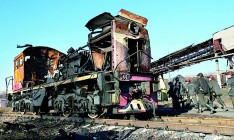Economy
signalsIn H1 the losses of Ukrainian companies increased fourfold

The war in the east of Ukraine, loss of the Russian market and hryvnia devaluation have made nearly a half of Ukrainian businesses unprofitable. The State Statistics Service reported that the share of large and medium enterprises that suffered losses in the first half of the year increased from 43% in H1 2013 to 46%, while the size of their losses grew fourfold – from UAH 73.7 bn (UAH 71.6 not taking into account Crimea) to UAH 290 bn. Companies operating in the combat action zone in the Donetsk and Luhansk oblasts and in the Dnipropetrovsk oblast, where companies largely depend on the supplies from these two regions, quite logically sustained highest losses. These three oblasts together accounted for 25% of the country’s losses. Another 50% of the losses were registered in the nation’s capital, where many companies, including those operating in Donbas, are registered. Taking into account that the companies that managed to turn a profit did not see a substantial increase in their earnings (9.5% to UAH 74.5 bn), the net loss of Ukrainian business soared by 37 times from UAH 5.8 bn (UAH 4.7 bn not taking into account Crimea) to UAH 215.5 bn.
With no reason to grow
Practically all sectors of the economy have been affected by losses. The highest level of profitability was preserved in the mining industry (30.1%), manufacturing of pharmaceuticals (13.3%) and food, beverages and tobacco products (5.9%). Also, metallurgy enterprises were somewhat profitable (2.4%). At the same time, machine engineering sustained losses of 1.5% and the chemical industry (24.2%).
The machine engineering sector was hit by the decrease in demand from Russia. In September-October 2013, Moscow prohibited the import of railway cars manufactured by four Ukrainian plants, which account for 80% of domestic output, specifically Kryukov Car Building Works (KCBW), Azovmash, Dniprovahonmash and the Stakhanov Car Building Plant (SCBP). Later, the ban was lifted, but export to Russia did not fully recover – in H1 2014 the export of railway locomotives to Russian declined by 57%.
As a result, over the first six months of the year, railway production decreased by 77.1% and manufacturers began losing profits. For example, the net profit of Dniprovahonmash dropped tenfold in January-June to UAH 15.4 bn. SCBP, which declared UAH 55.9 mn in profits in H1 2013, today registered UAH 82.9 mn in net losses. In addition, some manufacturers that depended on supplies from the east suffered from the combat actions. For instance, Zaporizhzhya Automobile Plant (ZAZ), which recently closed shop, received 30-40% components from there. Due to the combat actions in Donbas, the plant was forced to use the components from its warehouses, thus reducing its production volumes.
Without outside support
Noteworthy, agrarian companies that politicians and experts viewed as the driving force of the economy and a source of export earnings this year also suffered losses in the first half of the year. As the Ukrainian Club of Agrarian Business association (UCAB) reported, thanks to the increase in yield in the 2013-2014 fiscal year, which ended in June, wheat output grew over the year by 41.3% to 22.3 mn t, barley – 9% to 7.6 mn t. Grain export from Ukraine in 2013-2014 totaled 32.4 mn t, which is 42% more than in the previous season, according to the Ministry of Agrarian Policy and Food. In particular, in H1 2014, sales of grain abroad increased 20.8%. However, despite growth of yield and exports, the level of unprofitability of farming, forestry and fishing companies in January-June amounted to 3.8%, although a year ago they showed profitability of 1.4%.
Head of the Analytical Department at SP Advisors Vitaliy Vavryshchuk explained that the reason for this was the record harvest all over the world, which knocked down grain prices that reached their high in 2014 to a four-year low. In H1 alone wheat prices dropped 6.7%.
In general, Ukrainian business is not expecting the situation to improve much in the second half of the year. According to the results of a survey conducted by the National Bank of Ukraine in June among companies, only 27% of them expected improvement of the financial and economic situation over the next year. Furthermore, companies in the Donetsk oblast were least optimistic (12%). However, after active combats in August-September, which caused considerable destruction to the local infrastructure and production problems, the moods of the companies today may be more pessimistic.

Это и не удивительно в условиях войны и утраты российского рынка. На европейский нам не выйти еще долго, а жить надо сегодня и каждый день. Но, как ни странно, когда, к примеру, комми говорили очевидные вещи , в них плевали бросали булыжниками. А сейчас, когда страна на грани катастрофы, олигархи пытаются еще и судить их, чтобы самим избежать ответственности.






 of the agreement of syndication with Financial Times Limited are strictly prohibited. Use of materials which refers to France-Presse, Reuters, Interfax-Ukraine, Ukrainian News, UNIAN agencies is strictly prohibited. Materials marked
of the agreement of syndication with Financial Times Limited are strictly prohibited. Use of materials which refers to France-Presse, Reuters, Interfax-Ukraine, Ukrainian News, UNIAN agencies is strictly prohibited. Materials marked  are published as advertisements.
are published as advertisements.